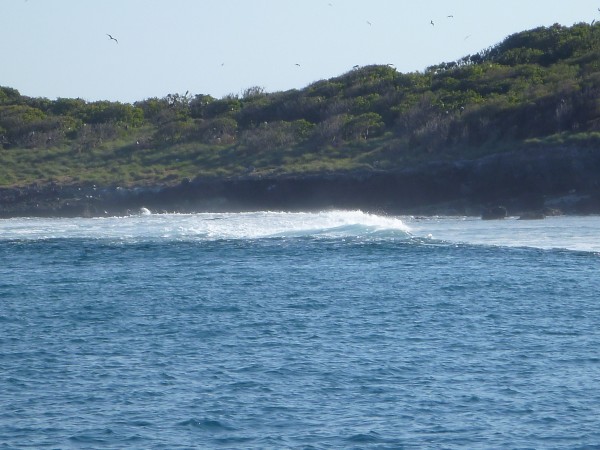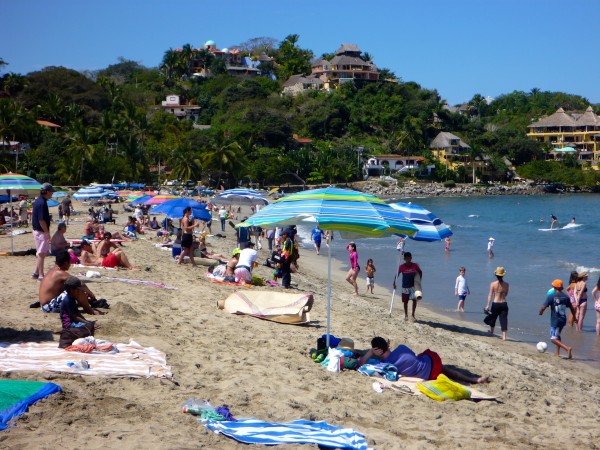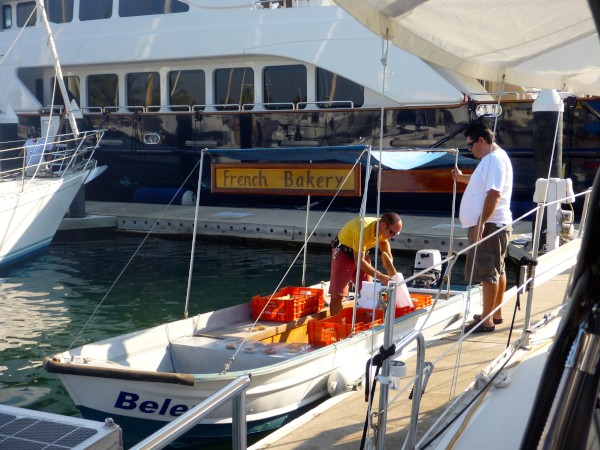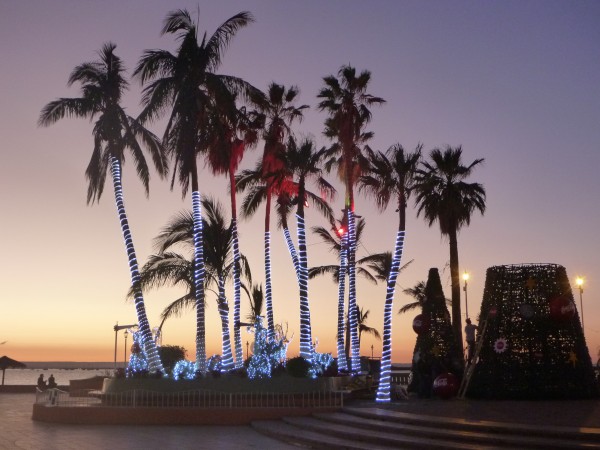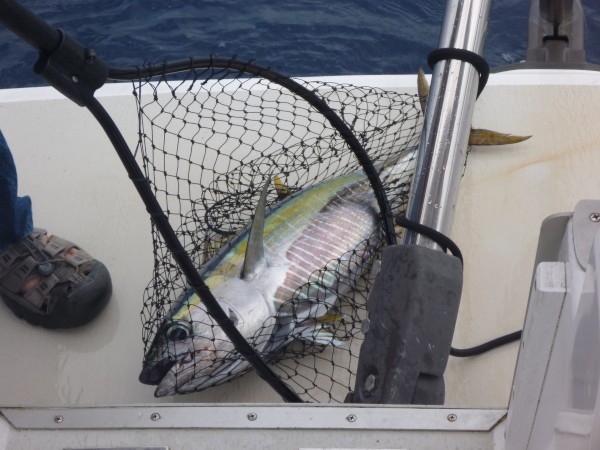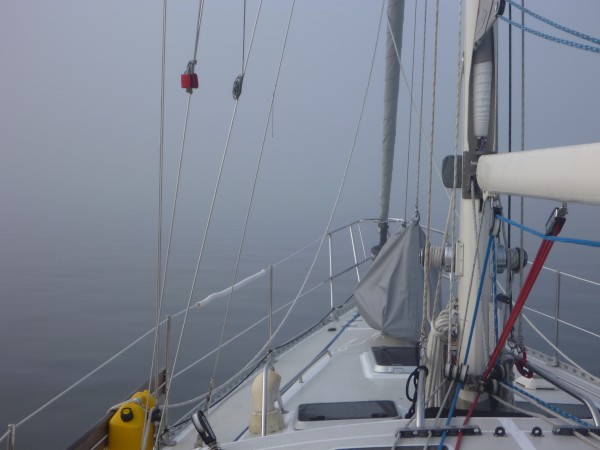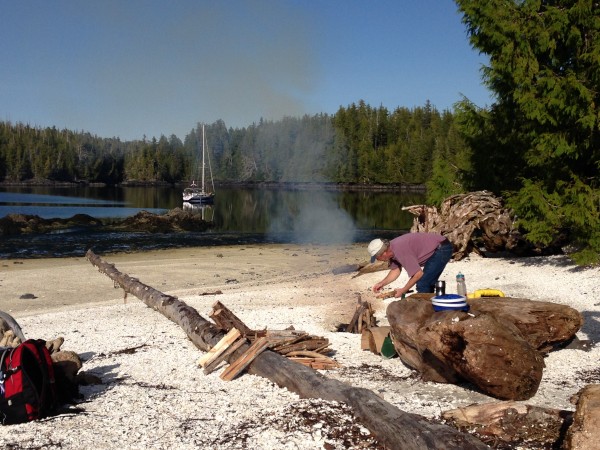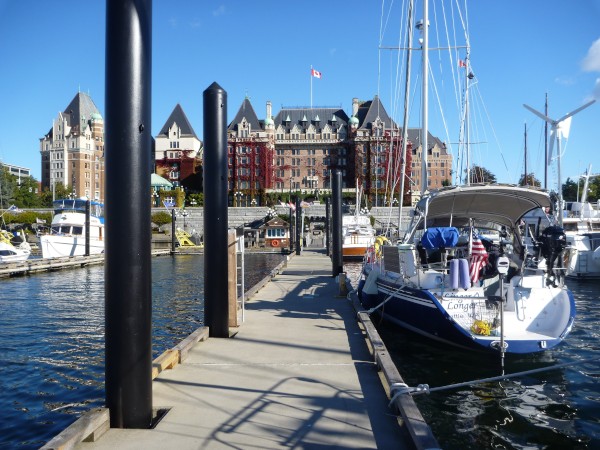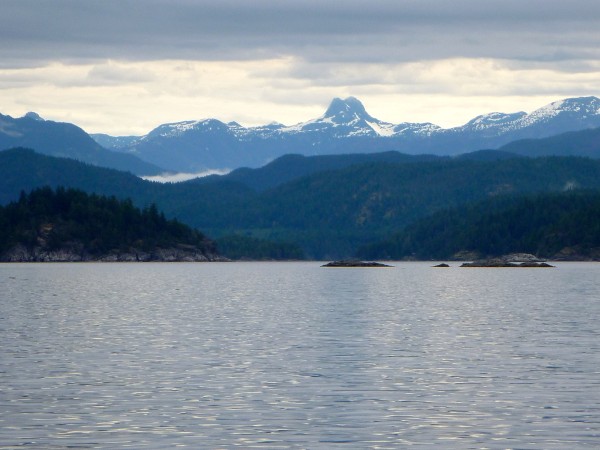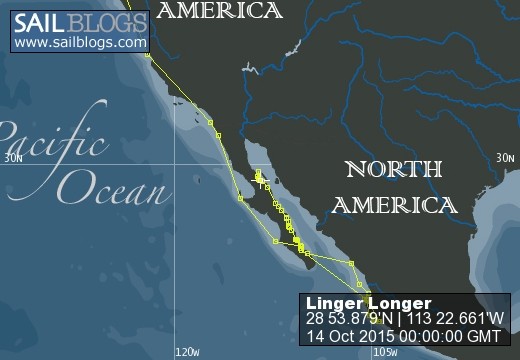
Linger Longer
14 September 2016
06 August 2016
09 July 2016
19 March 2016
19 December 2015
18 December 2015
18 December 2015
03 November 2015
18 July 2015
24 May 2015
04 April 2015
31 March 2015
26 February 2015
15 February 2015 | Barra de Navidad
07 February 2015 | Tenacatita Bay
04 February 2015
26 January 2015 | 19 18.051'N
04 January 2015 | La Cruz, Nayarit, Mexico
25 December 2014 | La Paz, Baja California Sur, Mexico
01 December 2014 | Ensenada, Mexico
Reflections by Kirk
25 December 2014 | La Paz, Baja California Sur, Mexico
Sunny & warm
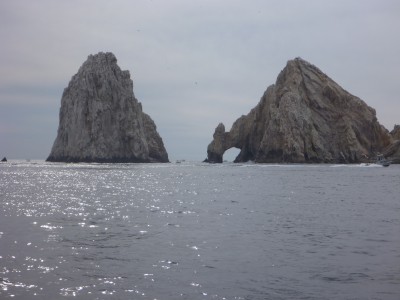
(Photo - Lands End, Cabo San Lucas)
So we are now in La Paz, Baja California Sur, Mexico (southern Baja Peninsula). Since leaving Glacier Bay Alaska, we have enjoyed well over 3,000 miles of coastal cruising of which about 2,000 miles has been in the Pacific Ocean. What is it like to cruise upon the waters of the Pacific Ocean in a small boat? Is it tedious and boring? Is it exciting? Is it scary? At times the answer to all of these questions would be yes.
The first question that many non-boaters ask us is “where do you stop for the night?” There is nowhere to stop. The water is usually several thousand feet deep and our anchor rode is only 450 feet long. So the only option is to actively operate the boat 24/7. This really takes some serious consideration in operating tactics and in how you set up the boat. The water tends to be much bigger in the ocean than in “protected waters” like Puget Sound, the Salish Sea, the Inside Passage to Alaska or on the east coast to Florida. There is always some kind of ocean swell. Swell is waves that were generated hundreds, or more likely thousands, of miles away. These waves just keep on rolling along until they run into something very shallow like land or reefs. The wind affects the characteristics of the swell. If the wind has been strong from the same direction for several days, the swell will be larger. Local wind will make its own set of wind waves. Stronger winds make bigger waves. If the local winds are coming from a different direction than the swell, the boat tends to get jostled around more. Sometimes there is a long period between swells and the boat just kind of gently moves up and down. Other times the motion is a bit more active. It doesn’t matter whether the motion is gentle or more violent; you ALWAYS need to hold on to something when moving around, as there is ALWAYS movement of the boat. A cardinal rule of boating is “One hand for yourself and one hand for the boat.” You must take this rule very seriously when out in the ocean on a small boat.
So all of this motion, which can sometimes be a bit violent, is one of the things that must be taken into consideration. Pots, pans, bottles, dishes, cutlery, etc. must be stowed in a manner that keeps them from flying about and eliminates constant irritating rattles. Old worn out socks come in handy. Knives must be secure in their holders. Cooking is different. Preprepared food that can be eaten right out of its container is nice. If we do cook, meals that can be prepared in one pot are preferred. The stove must be gimbaled. This means that it is free to swing. As the boat roles from side to side, the stove will swing so that it remains reasonably level. Pots must have tight fitting lids. All of this so we do not have food sloshing out of the pots onto the stove or even worse onto the cook. The cook must wedge the body in such a way that one is not hurled across the cabin whilst using both hands to prepare or serve the meal. If it is rough, we will leave dirtied dishes in the sink where they annoyingly rattle around. Washing drying and stowing dishes sounds simple, but it is not. There is no way that a drying rack works, at least on our boat. So you have to figure out how to wash, rinse, dry and stow each piece before it flies away and goes bouncing down the cabin floor, all the while working hard just to remain upright. As a male, the simple act of peeing takes on a whole new dimension. Just standing there and letting fly does not work so well when aiming at a constantly moving target. I must drop the drawers and sit down just the same as the more civilized sex.
Good rest, as in sleep, is extremely important. When on watch it is necessary to remain mentally alert enough to react positively to any situation that may develop. Our sleep cycles are totally different than when we are at anchor or tied to a dock since there must always be someone on watch. As I may have mentioned previously, it is a written international law of the sea, as well as common sense, that someone must always be on watch, primarily to avoid other vessels, but also to monitor and take action for changing weather and sea state, to insure that the boat is performing properly, and to try and avoid running into things like whales and partially sunken containers. With two people on the boat, maintaining a watch 24/7 can be a bit of a challenge. Everyone is different and different people on different boats may have different ways of making watch schedules. Kris and I find that four hours on watch is about as long as we can maintain any semblance of focus. Three hours would be easier, but then the person who is off watch can really only get about two and one half hours sleep before needing to be back up on watch again as it takes time to make log entries, get dressed, and maybe make a cup of tea. So one is never able to get a “full night’s sleep.” I know it sounds impossible, but after doing this enough times, the body figures out how to make do with a few shorter periods of rest rather than a prolonged one in the course of a day.
We seldom stand behind the wheel and actively steer the boat. Depending on whether we are sailing or motoring we have devices that steer the boat for us. When sailing, we use a wind vane steering system. There are a few different types available and ours is called a Hydrovane, made in the United Kingdom and distributed by a company in British Columbia. This device is wonderful in its simplicity. On the top is the vane there is an aluminum frame covered with very lightweight nylon fabric that moves with the slightest wind. The vane is attached to a rod, which is connected to an arm-like assembly, which is connected to some gears, which turn a rudder. When we engage the device, we set it up so the leading edge of the vane is pointed directly into the wind. If a wave or whatever changes the course of the boat, wind will strike the vane on one side or the other instead of directly on the leading edge. This causes the vane to tilt to the side, which lifts the rod causing the arm-like assembly to move in the appropriate direction causing the rudder to turn in the correct direction to get the boat heading in the correct attitude to the wind. This device needs only the power of the wind and will work without complaint for hour after hour after hour. If the wind changes direction, say changing from a southerly direction to a westerly direction, the boat will also change course to maintain the same attitude to the wind. The wind vane steerer will always work to keep its leading edge pointed directly into the direction from which the wind is blowing. So even though we are not actively steering the boat, it is still important to maintain a watch in case conditions change and we need to make adjustments. If we are motoring, we have an electro/mechanical autopilot. This is another ingenious device, a combination of electronic and mechanical wizardry. We select a spot by placing a cursor on our chart plotter screen, and then push a button. The autopilot will then steer the boat to the selected place making whatever adjustments are needed to account for wind and/or current to get us there. Although we have not attempted it yet, we can program a series of points that will take us all the way to some distant place even if the route requires several different course changes. Theoretically, we could do all of this programming, push a button and say wake us up when we get to Tahiti.
It is most advantageous to be able to have some idea of what the weather will be like along our chosen course. With our onboard single sideband radio (also operates as a Ham radio) as well as the sat phone, we can receive fairly accurate weather forecasts. Along with our own observations of the barometer and looking at the sky, we have not had too many weather surprises. All of the gadgetry available today, GPS, radar, autopilots, AIS, sat phones, ham radios, etc., have taken much of the mystery out of sailing the oceans, but have also made it possible for mere mortals, like ourselves, to undertake such adventures with a reasonably high degree of safety. That is why so many people like us are out here seeing the world from the decks of their own boat.
Is it boring? What do you do all day? Valid questions all. While it would seem that a horizon, unbroken by trees, mountains or skyscrapers may not be all that inspiring, the endless rolling of the swell and waves can become quite mesmerizing. Off in the distance an unusually high swell, perhaps with a wind wave on top, will attract the eye and one’s focus will then be on the myriad of shapes created by waves far away. Watching swell and waves close to the boat is fascinating. For me it is the most fun when there is a big swell coming from astern. Not a huge swell, maybe two to three meters. The swell always moves much faster than our boat. It looks like a mountain of water is about to devour the boat as it approaches. Then the stern lifts up and the swell passes harmlessly under the boat. When the stern drops back down on the backside of the swell, the next one approaching looks absolutely huge, but it too will pass harmlessly under our boat. I was off watch, but Kris was in the cockpit when at least two entirely rude waves decided to enter our open transom and proceeded to wet her shoes/socks. We have not yet been in seas when we would need to put the board into the opening of our transom, but it will happen someday in conditions that will most likely require changes of under-drawers.
The number of birds living at sea far away from land is amazing. I cannot remember a day at sea, even when we made the passage from Maui to Seattle on Antares, some days over 1,000 miles from any land, that we did not see birds. Off the California coast we had the company of some colorful Warblers more than 20 miles offshore. They were obviously not afraid of us as they walked over our shoes, perched on our heads and shoulders and just hung around for several hours before disappearing in search of a boat with better food or water. Flying fish, even though fish and not birds, can fly a few hundred yards all within a few feet of the ocean surface. They flap their fins, which really look like wings and really do fly, even changing directions to go over or around waves. Most mornings, when in warm waters, we find a few who did not realize that a boat was directly in the line of flight and we have to remove their carcasses from the deck.
Marine mammals, whales and porpoises, are always highlights that will bring the off watch person up to the cockpit. With whales we usually see the spouts and try not to get too close; but on occasion, we get surprised and see one surface a little too close for our comfort. Porpoises are very cool. During the day, it looks like a bunch of whitecaps are approaching the boat. As they get close enough, it turns out to be many, sometimes hundreds, of porpoises. They always come by to check us out and usually play around the boat for a while. At night it has to be a really bright to see them coming so it is usually a case of hearing them break the surface to take another breath. I usually hear an unusual noise a few times before it sinks in that I should look over the side. I always talk to them at night probably because it can get a bit lonely on night watch.
Since I have always lived in suburbia where ambient light can obscure the stars, clear nights at sea never fail to make me feel a spiritual awakening. In only a few places on land, Death Valley, river gorges in Utah, and the foothills inland from Yachats, OR, have I seen such brilliant displays from the heavens that we can routinely see out at sea. When the seas are calm, countless brilliant specks of light stretch from horizon to horizon with reflections on the water surface. A band of stars so thick together that it appears to be a gauzy band identifies the Milky Way stretching all the way across the sky. When you add to that a trail of phosphorescence behind the boat, the wonder of the universe strikes right to the core.
Kris and I try to work the watch schedule so one gets to see the sunset and the other the sunrise. I don’t think that I have the words to describe the variety of beauty that happens out there twice a day.
In all fairness, it is not always beauty and wonder. Weather has the ability to conspire against a small boat. Wind, waves, fog, fishing boats at night, motion sickness, plugged fuel filters and such can add some anxiety, but it is what it is and we learn to take the good with the not so good. In fact, I really think the not so good is necessary to appreciate the good, so in a weird kind of way the not so good really is good. Oh yea, there is a lot of time to think and sometimes the mind can wander to previously unexplored places.
Eso es lo que es. (It is what it is)
Kirk
So we are now in La Paz, Baja California Sur, Mexico (southern Baja Peninsula). Since leaving Glacier Bay Alaska, we have enjoyed well over 3,000 miles of coastal cruising of which about 2,000 miles has been in the Pacific Ocean. What is it like to cruise upon the waters of the Pacific Ocean in a small boat? Is it tedious and boring? Is it exciting? Is it scary? At times the answer to all of these questions would be yes.
The first question that many non-boaters ask us is “where do you stop for the night?” There is nowhere to stop. The water is usually several thousand feet deep and our anchor rode is only 450 feet long. So the only option is to actively operate the boat 24/7. This really takes some serious consideration in operating tactics and in how you set up the boat. The water tends to be much bigger in the ocean than in “protected waters” like Puget Sound, the Salish Sea, the Inside Passage to Alaska or on the east coast to Florida. There is always some kind of ocean swell. Swell is waves that were generated hundreds, or more likely thousands, of miles away. These waves just keep on rolling along until they run into something very shallow like land or reefs. The wind affects the characteristics of the swell. If the wind has been strong from the same direction for several days, the swell will be larger. Local wind will make its own set of wind waves. Stronger winds make bigger waves. If the local winds are coming from a different direction than the swell, the boat tends to get jostled around more. Sometimes there is a long period between swells and the boat just kind of gently moves up and down. Other times the motion is a bit more active. It doesn’t matter whether the motion is gentle or more violent; you ALWAYS need to hold on to something when moving around, as there is ALWAYS movement of the boat. A cardinal rule of boating is “One hand for yourself and one hand for the boat.” You must take this rule very seriously when out in the ocean on a small boat.
So all of this motion, which can sometimes be a bit violent, is one of the things that must be taken into consideration. Pots, pans, bottles, dishes, cutlery, etc. must be stowed in a manner that keeps them from flying about and eliminates constant irritating rattles. Old worn out socks come in handy. Knives must be secure in their holders. Cooking is different. Preprepared food that can be eaten right out of its container is nice. If we do cook, meals that can be prepared in one pot are preferred. The stove must be gimbaled. This means that it is free to swing. As the boat roles from side to side, the stove will swing so that it remains reasonably level. Pots must have tight fitting lids. All of this so we do not have food sloshing out of the pots onto the stove or even worse onto the cook. The cook must wedge the body in such a way that one is not hurled across the cabin whilst using both hands to prepare or serve the meal. If it is rough, we will leave dirtied dishes in the sink where they annoyingly rattle around. Washing drying and stowing dishes sounds simple, but it is not. There is no way that a drying rack works, at least on our boat. So you have to figure out how to wash, rinse, dry and stow each piece before it flies away and goes bouncing down the cabin floor, all the while working hard just to remain upright. As a male, the simple act of peeing takes on a whole new dimension. Just standing there and letting fly does not work so well when aiming at a constantly moving target. I must drop the drawers and sit down just the same as the more civilized sex.
Good rest, as in sleep, is extremely important. When on watch it is necessary to remain mentally alert enough to react positively to any situation that may develop. Our sleep cycles are totally different than when we are at anchor or tied to a dock since there must always be someone on watch. As I may have mentioned previously, it is a written international law of the sea, as well as common sense, that someone must always be on watch, primarily to avoid other vessels, but also to monitor and take action for changing weather and sea state, to insure that the boat is performing properly, and to try and avoid running into things like whales and partially sunken containers. With two people on the boat, maintaining a watch 24/7 can be a bit of a challenge. Everyone is different and different people on different boats may have different ways of making watch schedules. Kris and I find that four hours on watch is about as long as we can maintain any semblance of focus. Three hours would be easier, but then the person who is off watch can really only get about two and one half hours sleep before needing to be back up on watch again as it takes time to make log entries, get dressed, and maybe make a cup of tea. So one is never able to get a “full night’s sleep.” I know it sounds impossible, but after doing this enough times, the body figures out how to make do with a few shorter periods of rest rather than a prolonged one in the course of a day.
We seldom stand behind the wheel and actively steer the boat. Depending on whether we are sailing or motoring we have devices that steer the boat for us. When sailing, we use a wind vane steering system. There are a few different types available and ours is called a Hydrovane, made in the United Kingdom and distributed by a company in British Columbia. This device is wonderful in its simplicity. On the top is the vane there is an aluminum frame covered with very lightweight nylon fabric that moves with the slightest wind. The vane is attached to a rod, which is connected to an arm-like assembly, which is connected to some gears, which turn a rudder. When we engage the device, we set it up so the leading edge of the vane is pointed directly into the wind. If a wave or whatever changes the course of the boat, wind will strike the vane on one side or the other instead of directly on the leading edge. This causes the vane to tilt to the side, which lifts the rod causing the arm-like assembly to move in the appropriate direction causing the rudder to turn in the correct direction to get the boat heading in the correct attitude to the wind. This device needs only the power of the wind and will work without complaint for hour after hour after hour. If the wind changes direction, say changing from a southerly direction to a westerly direction, the boat will also change course to maintain the same attitude to the wind. The wind vane steerer will always work to keep its leading edge pointed directly into the direction from which the wind is blowing. So even though we are not actively steering the boat, it is still important to maintain a watch in case conditions change and we need to make adjustments. If we are motoring, we have an electro/mechanical autopilot. This is another ingenious device, a combination of electronic and mechanical wizardry. We select a spot by placing a cursor on our chart plotter screen, and then push a button. The autopilot will then steer the boat to the selected place making whatever adjustments are needed to account for wind and/or current to get us there. Although we have not attempted it yet, we can program a series of points that will take us all the way to some distant place even if the route requires several different course changes. Theoretically, we could do all of this programming, push a button and say wake us up when we get to Tahiti.
It is most advantageous to be able to have some idea of what the weather will be like along our chosen course. With our onboard single sideband radio (also operates as a Ham radio) as well as the sat phone, we can receive fairly accurate weather forecasts. Along with our own observations of the barometer and looking at the sky, we have not had too many weather surprises. All of the gadgetry available today, GPS, radar, autopilots, AIS, sat phones, ham radios, etc., have taken much of the mystery out of sailing the oceans, but have also made it possible for mere mortals, like ourselves, to undertake such adventures with a reasonably high degree of safety. That is why so many people like us are out here seeing the world from the decks of their own boat.
Is it boring? What do you do all day? Valid questions all. While it would seem that a horizon, unbroken by trees, mountains or skyscrapers may not be all that inspiring, the endless rolling of the swell and waves can become quite mesmerizing. Off in the distance an unusually high swell, perhaps with a wind wave on top, will attract the eye and one’s focus will then be on the myriad of shapes created by waves far away. Watching swell and waves close to the boat is fascinating. For me it is the most fun when there is a big swell coming from astern. Not a huge swell, maybe two to three meters. The swell always moves much faster than our boat. It looks like a mountain of water is about to devour the boat as it approaches. Then the stern lifts up and the swell passes harmlessly under the boat. When the stern drops back down on the backside of the swell, the next one approaching looks absolutely huge, but it too will pass harmlessly under our boat. I was off watch, but Kris was in the cockpit when at least two entirely rude waves decided to enter our open transom and proceeded to wet her shoes/socks. We have not yet been in seas when we would need to put the board into the opening of our transom, but it will happen someday in conditions that will most likely require changes of under-drawers.
The number of birds living at sea far away from land is amazing. I cannot remember a day at sea, even when we made the passage from Maui to Seattle on Antares, some days over 1,000 miles from any land, that we did not see birds. Off the California coast we had the company of some colorful Warblers more than 20 miles offshore. They were obviously not afraid of us as they walked over our shoes, perched on our heads and shoulders and just hung around for several hours before disappearing in search of a boat with better food or water. Flying fish, even though fish and not birds, can fly a few hundred yards all within a few feet of the ocean surface. They flap their fins, which really look like wings and really do fly, even changing directions to go over or around waves. Most mornings, when in warm waters, we find a few who did not realize that a boat was directly in the line of flight and we have to remove their carcasses from the deck.
Marine mammals, whales and porpoises, are always highlights that will bring the off watch person up to the cockpit. With whales we usually see the spouts and try not to get too close; but on occasion, we get surprised and see one surface a little too close for our comfort. Porpoises are very cool. During the day, it looks like a bunch of whitecaps are approaching the boat. As they get close enough, it turns out to be many, sometimes hundreds, of porpoises. They always come by to check us out and usually play around the boat for a while. At night it has to be a really bright to see them coming so it is usually a case of hearing them break the surface to take another breath. I usually hear an unusual noise a few times before it sinks in that I should look over the side. I always talk to them at night probably because it can get a bit lonely on night watch.
Since I have always lived in suburbia where ambient light can obscure the stars, clear nights at sea never fail to make me feel a spiritual awakening. In only a few places on land, Death Valley, river gorges in Utah, and the foothills inland from Yachats, OR, have I seen such brilliant displays from the heavens that we can routinely see out at sea. When the seas are calm, countless brilliant specks of light stretch from horizon to horizon with reflections on the water surface. A band of stars so thick together that it appears to be a gauzy band identifies the Milky Way stretching all the way across the sky. When you add to that a trail of phosphorescence behind the boat, the wonder of the universe strikes right to the core.
Kris and I try to work the watch schedule so one gets to see the sunset and the other the sunrise. I don’t think that I have the words to describe the variety of beauty that happens out there twice a day.
In all fairness, it is not always beauty and wonder. Weather has the ability to conspire against a small boat. Wind, waves, fog, fishing boats at night, motion sickness, plugged fuel filters and such can add some anxiety, but it is what it is and we learn to take the good with the not so good. In fact, I really think the not so good is necessary to appreciate the good, so in a weird kind of way the not so good really is good. Oh yea, there is a lot of time to think and sometimes the mind can wander to previously unexplored places.
Eso es lo que es. (It is what it is)
Kirk
Comments
| Vessel Name: | S/V Linger Longer |
| Vessel Make/Model: | Sceptre 41/43 |
| Hailing Port: | Seattle, WA |
| Crew: | Kirk & Kristin Doyle |
| Extra: | |
| Home Page: | http://www.k2doyle.com |
S/V Linger Longer's Photos - Main
|
Heading north into the Sea of Cortez for the summer where there is less change of hurricanes.
72 Photos
Created 19 December 2015
|
Who: Kirk & Kristin Doyle
Port: Seattle, WA
